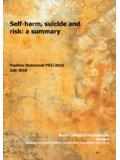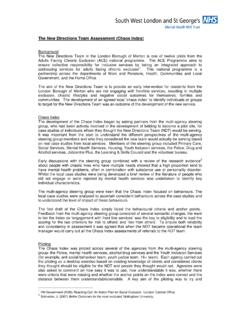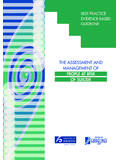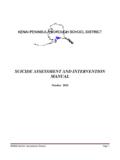Transcription of Briviact RMP summary - European Medicines Agency
1 PART VI: summary OF THE RISK MANAGEMENT PLAN summary of risk management plan for Briviact This is a summary of the risk management plan (RMP) for Briviact . The RMP details important risks of Briviact , how this risk can be minimized, and how more information will be obtained about Briviact 's risks and uncertainties (missing information). Briviact 's summary of product characteristics (SmPC) and its package leaflet give essential information to healthcare professionals and patients on how Briviact should be used. This summary of the RMP for Briviact should be read in the context of all this information including the assessment report of the evaluation and its plain-language summary , all which is part of the European Public Assessment Report (EPAR).
2 Important new concerns or changes to the current ones will be included in updates of Briviact 's RMP. 1 THE MEDICINE AND WHAT IT IS USED FOR Briviact is authorised for adjunctive therapy in the treatment of partial-onset seizures with or without secondary generalization in adult and adolescent patients from 4 years of age with epilepsy (see SmPC for the full indication). It contains brivaracetam as the active substance and it is given by oral tablet in the following strengths:10mg, 25mg, 50mg, 75mg, and 100mg film-coated tablets, or by 10mg/mL oral solution, or by injection of 10mg/mL solution for injection . Further information about the evaluation of Briviact s benefits can be found in Briviact s EPAR, including in its plain-language summary , available on the European Medicines Agency website, under the medicine s webpage: 2 risks ASSOCIATED WITH THE MEDICINE AND ACTIVITIES TO MINIMIZE OR FURTHER CHARACTERISE THE risks Important risks of Briviact , together with measures to minimize such risks and the proposed studies for learning more about Biviact's risks , are outlined below.
3 Measures to minimize the risks identified for medicinal products can be: Specific information, such as warnings, precautions, and advice on correct use, in the package leaflet and SmPC addressed to patients and healthcare professionals; Important advice on the medicine s packaging; The authorised pack size the amount of medicine in a pack is chosen so to ensure that the medicine is used correctly; The medicine s legal status the way a medicine is supplied to the patient (eg, with or without prescription) can help to minimize its risks . Together, these measures constitute routine risk minimization measures. In the case of Briviact , these measures are supplemented with additional risk minimization measures mentioned under relevant important risks , below.
4 In addition to these measures, information about adverse reactions is collected continuously and regularly analysed, including periodic safety update report assessment - so that immediate action can be taken as necessary. These measures constitute routine pharmacovigilance activities. If important information that may affect the safe use of Briviact is not yet available, it is listed under missing information below. List of important risks and missing information Important risks of Briviact are risks that need special risk management activities to further investigate or minimize the risk, so that the medicinal product can be safely taken. Important risks can be regarded as identified or potential.
5 Identified risks are concerns for which there is sufficient proof of a link with the use of Briviact . Potential risks are concerns for which an association with the use of this medicine is possible based on available data, but this association has not been established yet and needs further evaluation. Missing information refers to information on the safety of the medicinal product that is currently missing and needs to be collected (eg, on the long-term use of the medicine); Table 2 1: List of important risks and missing information List of important risks and missing information Important identified risks Suicidality (class label for anticonvulsant products) Aggression Important potential risks Neutropenia Worsening of seizures (as an anticonvulsant product) Abuse potential (as a CNS-active product)
6 Missing information Data during pregnancy and lactation Data in patients with pre-existing hepatic impairment Data in patients with pre-existing end-stage renal impairment requiring dialysis Data in elderly Clinical outcomes after an overdose Long-term safety Long-term effects on growth, endocrine function or sexual maturation, neurodevelopment, cognitive and psychomotor development in pediatric patients CNS=central nervous system summary of important risks Table 2 2: summary of important risks Important identified risk: Suicidality (class label for anticonvulsant products) Evidence for linking the risk to the medicine Suicide-related events have been reported more often in people who have epilepsy than in the general population.
7 Risk factors and risk groups Common additional disorders in patients with epilepsy that increase the risk of suicide include depression and learning difficulties or disability. A small increased risk of suicide-related events has also been reported in patients with epilepsy taking antiepileptic drugs including Briviact . Risk minimization measures Routine risk minimization measures: Available by prescription only SmPC Section (Special warnings and precautions for use [class wording]), and SmPC Section (Undesirable effects) Packaging: - The brivaracetam oral tablet pack contains unit dose packaging (blister) that requires a sequential withdrawal of the tablets, which could interfere with accomplishment of suicidal thoughts.
8 - Intravenous formulation is provided in vials containing 50mg of brivaracetam in total, and the administration will be performed by a health care professional and not the patient. Additional risk minimization measures: None Important identified risk: Aggression Evidence for linking the risk to the medicine A small increased risk of aggression has been reported in patients with epilepsy taking antiepileptic drugs including Briviact . Risk groups or risk factors The relationship between aggression and epilepsy is complex and not well understood. Some factors that have been reported to increase the risk for aggression in patients with epilepsy include organic cerebral disease, low socioeconomic status, and poor upbringing (Tebartz, 2002).
9 Aggression may result as a consequence of depression, anxiety, or in the context of an antisocial personality disorder (Kanner, 2004). Risk minimization measures Routine risk minimization measures: Available by prescription only SmPC Section (Undesirable effects) Additional risk minimization measures: None Important potential risk: Neutropenia Evidence for linking the risk to the medicine A slight decrease in neutrophils is not usually serious, but a large decrease can be serious and increase the chance of infection. Table 2 2: summary of important risks Risk factors and risk groups No additional risk factors have been identified. Risk minimization measures Routine risk minimization measures: Available by prescription only SmPC Section (Undesirable effects) Additional risk minimization measures: None Important potential risk: Worsening of seizures (as an anticonvulsant product) Evidence for linking the risk to the medicine Seizures may increase or become worse while taking Briviact .
10 However, these could be the results of changes in the patient s overall health or the underlying epilepsy getting worse. Risk factors and risk groups There are several risk factors that have been associated with seizure worsening or aggravation including changes in therapy, sleep deprivation, intercurrent illness, use of alcohol and other recreational drugs, over the counter medications, coadministration of seizure provoking drugs, drug interactions, hormonal changes, the development of drug resistance, fever, and nonadherence with therapy (Somerville, 2009). Drug-related seizure increase has been documented at higher rates among pregnant women (Reisinger et al, 2013). Additionally, patients are at higher risk post-epilepsy surgery (Sarkis et al, 2012).

















